Smartphone camera face-off: iPhone 8 Plus vs Note 8 vs iPhone 7 Plus
Apple (AAPL) and Samsung (SSNLF) offer some of the best smartphone cameras on the market. And while Apple’s dual-lens iPhone 7 Plus has a fantastic shooter, Samsung’s Galaxy Note 8, which also offers a dual-lens setup, is slightly better thanks to its richer colors and dual optical image stabilization (OIS).
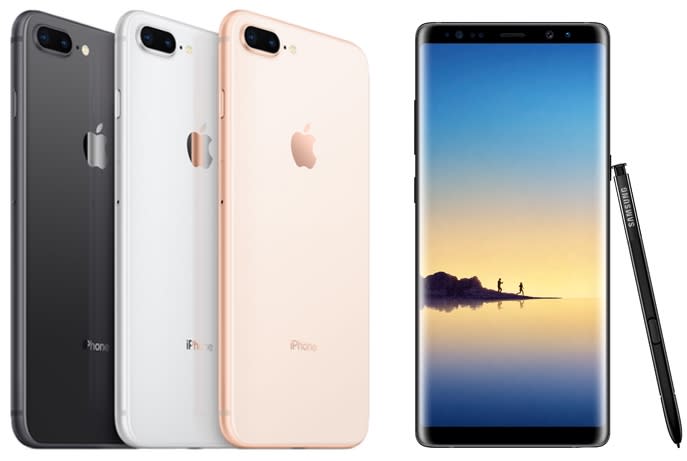
With its new iPhone 8 Plus, though, Apple is looking to turn the tables on Samsung.
So did Apple succeed? To determine that, I took the 7 Plus, Note 8 and 8 Plus out for a day of shooting around New York. I took all of the photos with HDR (high dynamic range) mode set to auto on each phone, to ensure a similar experience across devices.
Exterior landscape — The iPhone 8 Plus captures the cleanest, most accurate shot.
Close-up shot — The Note 8 took the most natural-looking photo.
Zoom — The iPhone 8 Plus shot the clearest picture with the best coloring.
Low-light — The iPhone’s photo is pixilated like the others’ shots, but offers the best color.
Portrait — The iPhone 8 Plus and Note 8 tied on this round, due to their own distinct flaws.
Exterior landscape
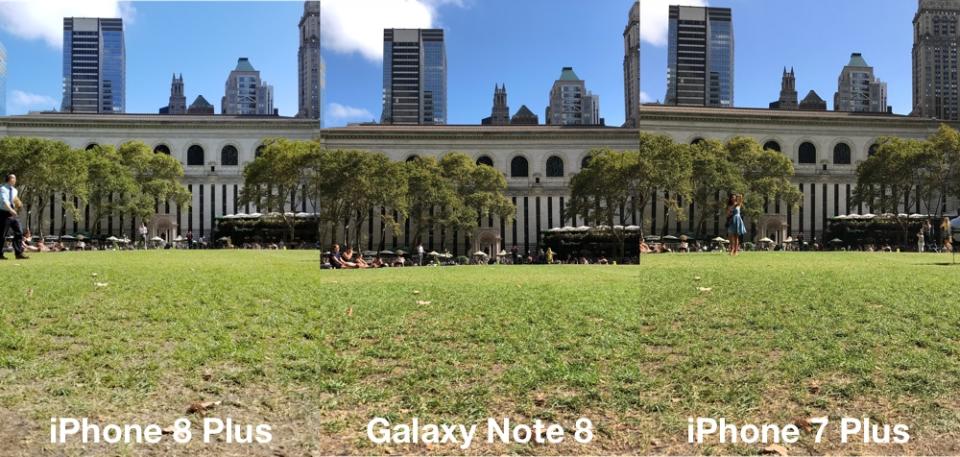
I tend to take the majority of my photos either from my couch when my cats are playing and I need some good Instagram fodder, but the rest of the time I’m capturing photos outside in direct sunlight. To test the cameras’ outdoor performance, I went to Manhattan’s Bryant Park and captured a photo of its large lawn, the rear of the New York Public Library and the surrounding buildings.
iPhone 8 Plus
The iPhone 8 Plus captured the most even-colored image of this scene. The azure sky never looks too white and the library’s roof is a deep brown. I also found the lawn to be a bit greener than the iPhone 7 Plus’s and the Note 8’s shots, but not by much.
Galaxy Note 8
The Galaxy Note 8’s photo is surprisingly overexposed versus the iPhone 8 Plus’s photo, especially around the sky and the library’s roof. Details, however, were just as clear and crisp as the iPhone 8 Plus’s photo.
iPhone 7 Plus
The iPhone 7 Plus’s shot falls directly in between the iPhone 8 Plus’s and Note 8’s images. The sky looks too white, but not nearly as much as the Note’s photo, and the library’s roof is a hair too bright.
Winner: iPhone 8 Plus
The iPhone 8 Plus offers the cleanest, most accurate photo of the group.
Close-up
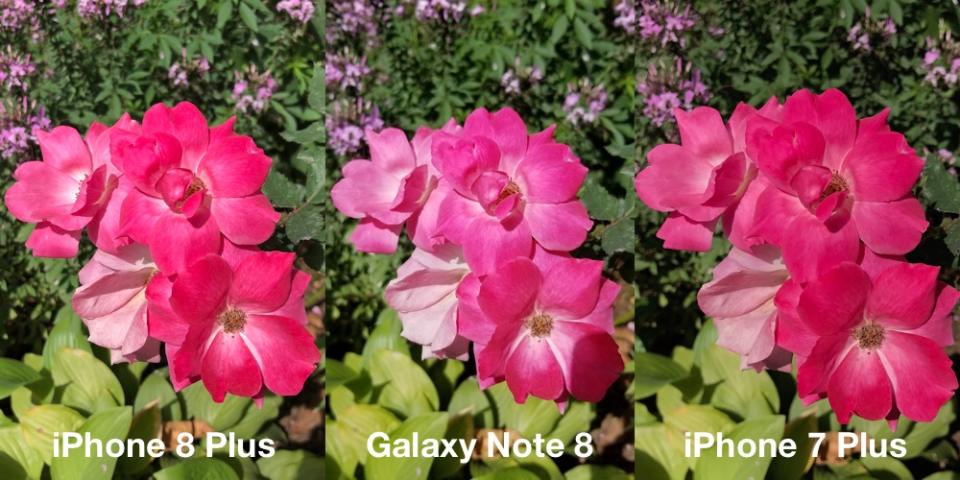
While at Bryant Park I decided to capture a close-up shot of a flower, so our readers will believe that I’m a sensitive soul. Joke’s on them.
iPhone 8 Plus
The iPhone 8 Plus once again proves it produces more vibrant colors in this shot, as the flower’s bright-pink petals look almost unnaturally deep. At the same time, details like the fine lines running throughout the petals are slightly harder to make out.
Note 8
Samsung’s Galaxy Note 7 accentuated the whites in this photo, making details easier to spot and the flower seem far more natural.
iPhone 7 plus
Much like the iPhone 8 Plus, the 7 Plus makes the flower look too over-saturated.
Winner: Note 8
While it’s not nearly as colorful as the iPhone 8 Plus’s photo or iPhone 7 Plus’s shot, the Note 8’s photo is the most natural looking.
Zoom
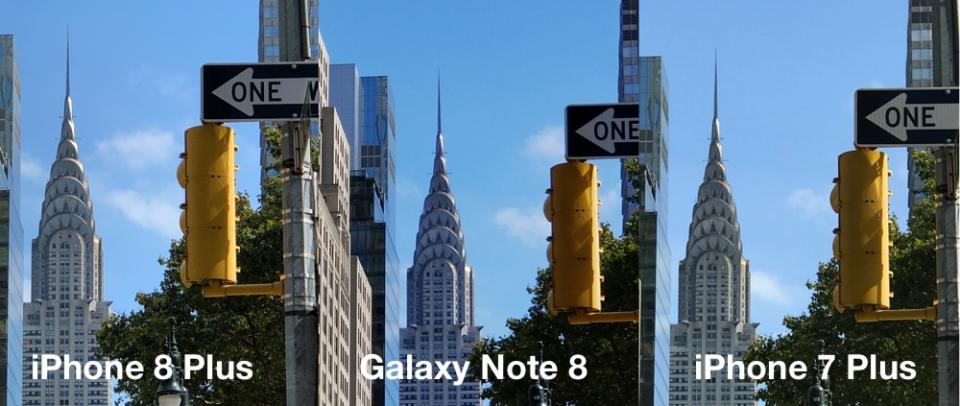
The biggest advantage of Apple’s and Samsung’s dual-lens cameras is that images look clearer when you zoom in. To test them I took a photo of the Chrysler Building with the zoom levels for the three phones set to 5x.
iPhone 8 Plus
The iPhone 8 Plus blew this test away. Not only do the colors look the most accurate, you can still see fine details in the tree in the foreground. That’s lost in both the iPhone 7 Plus’s and Note 8’s photos.
Galaxy Note 8
Samsung’s Note 8 made this image look too blue, especially when viewed side-by-side with the iPhone 8 Plus’s shot. The tree in the foreground is also too dark, causing it to lose definition between the leaves.
iPhone 7 Plus
While the Note 8 accentuated blues, the Note 7 seemed to accentuate browns in its photo. As a result, the image looks flatter than the Note’s or iPhone 8 Plus’s shots. The tree in the foreground is also too dark.
Winner: iPhone 8 Plus
The iPhone 8 Plus not only managed to capture the truest colors in this shot, but it also kept the tree in the foreground sharp enough for you to clearly see the leaves.
Low-light shot
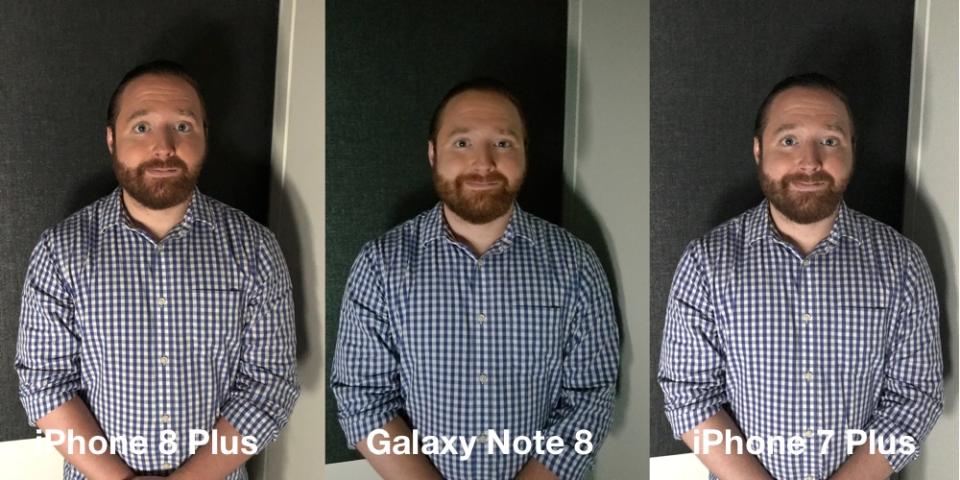
iPhone 8 Plus
The 8 Plus’s shot looked far brighter than the actual scene, which made it easier to make out from a distance. But like the Note 8’s and iPhone 7 Plus’s shots, when you zoom in on the 8 Plus’s image, it’s a mess of artifacts. But of the three, the iPhone 8 Plus offered the most natural colors and exposure.
Galaxy Note 8
The Note 8’s photo looks to have the best skin tone, but the wall in the lower right corner had a green hue, which threw off the rest of the photo.
iPhone 7 Plus
Apple’s iPhone 7 Plus took a washed out photo in this setting. The color almost has a sepia look to it.
Winner: iPhone 8 Plus
Smartphone cameras still leave a lot to be desired when it comes to taking low-light photos, but in this case the iPhone 8 Plus is the best.
Portrait shots
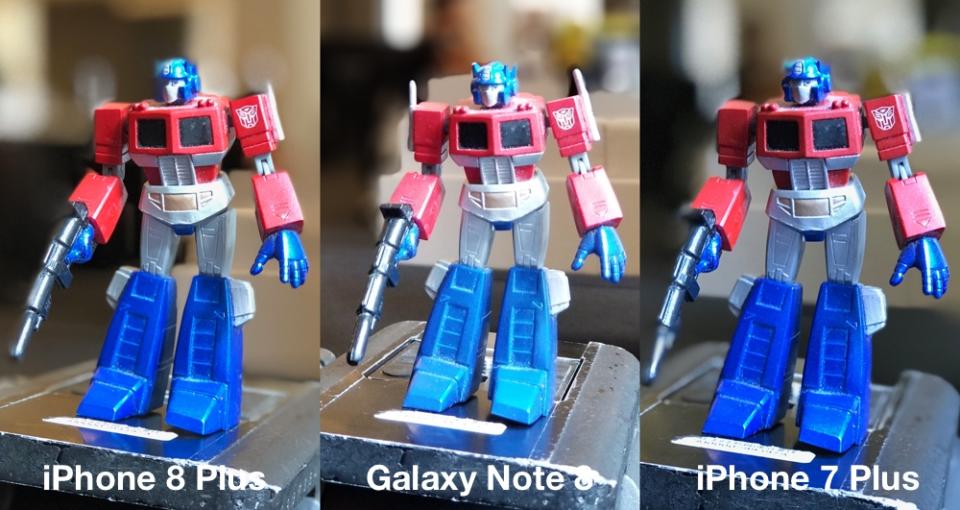
Beyond the ability to zoom in using optical rather than digital zoom, which makes for clearer photos, the iPhones and Note 8 use their dual-lens cameras to create a bokeh effect which blurs the background of images while keeping the foreground clear. It’s a great feature, when it works.
iPhone 8 Plus
When I took a photo of my coworker Chris using the iPhone 8’s portrait mode, the lighting in our office created a kind of orange effect. The blurring looked great and the overall shot was clear, but the coloring was strange.
A second shot of an Optimus Prime toy captured absolutely brilliant colors, but cut out finer details like the points of his head and the exhaust pipes on his arms.
Galaxy Note 8
The Note 8’s photo of Chris had a slightly purple hue. Our shot of Optimus Prime, meanwhile, was dull and flat, though his details were kept intact. Oddly, the couch behind Prime looked as though it was fully blurred.
iPhone 7 Plus
The iPhone 7 Plus’s photo of Chris was simply too dark, making it the worst of the three shots. The Optimus Prime photo, on the other hand, looked exactly the same as the iPhone 8 Plus’s image, right down to the missing details.
Winner: Tie between iPhone 8 Plus and Note 8
Both the iPhone 8 Plus and Note 8 have their own flaws in these shots, but they’re better than the iPhone 7 Plus.
Overall winner: Apple’s iPhone 8 Plus
Each of the smartphones in this face-off capture exceptional photos, but after scrutinizing their respective images, it’s clear — pun intended — that Apple’s iPhone 8 Plus is at the top.
More from Dan:
SNES Classic Review: The Super Nintendo is back, and you’re in for nostalgia overload
Samsung Galaxy Note 8 review: A big phone with bigger expectations
Email Daniel at dhowley@yahoo-inc.com; follow him on Twitter at @DanielHowley.


